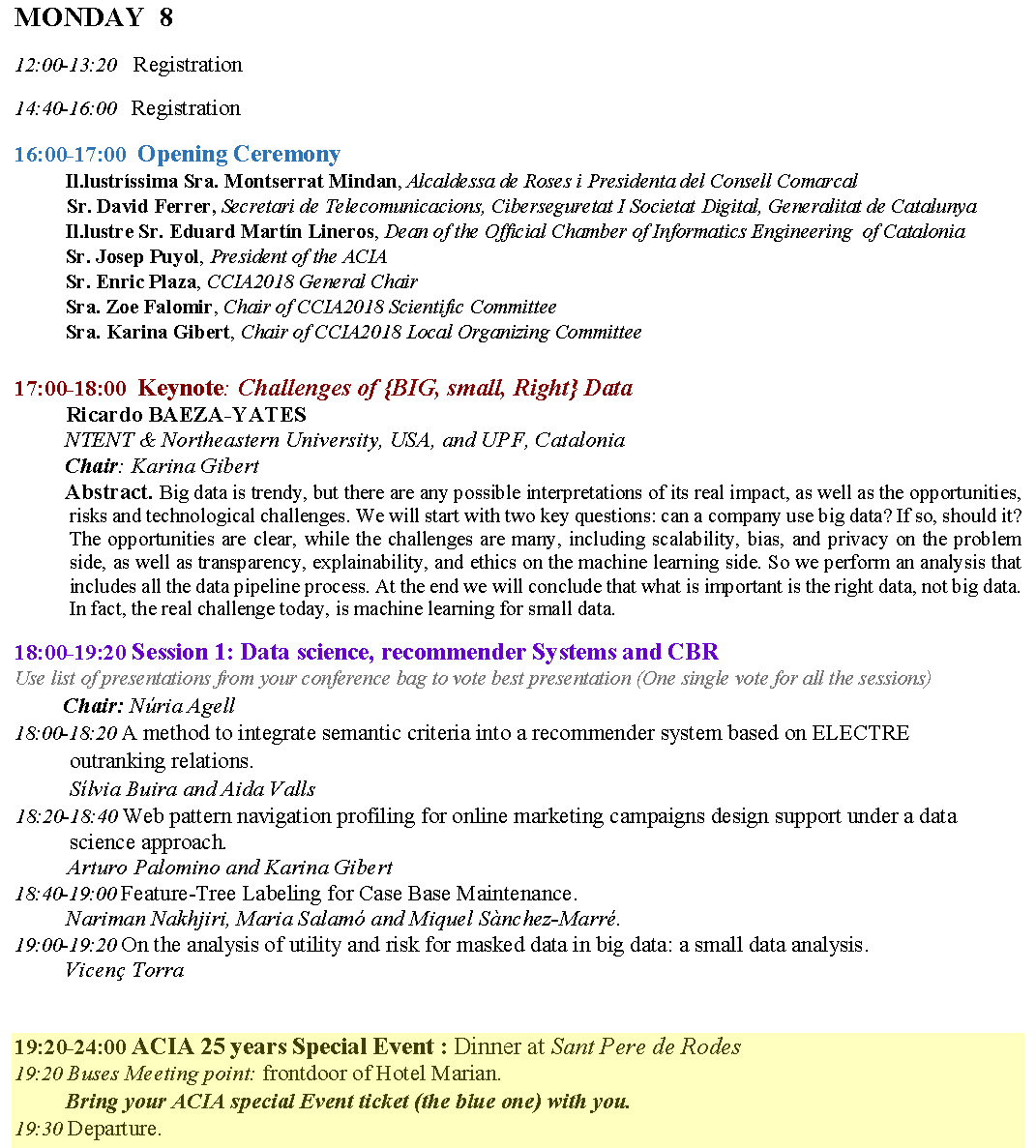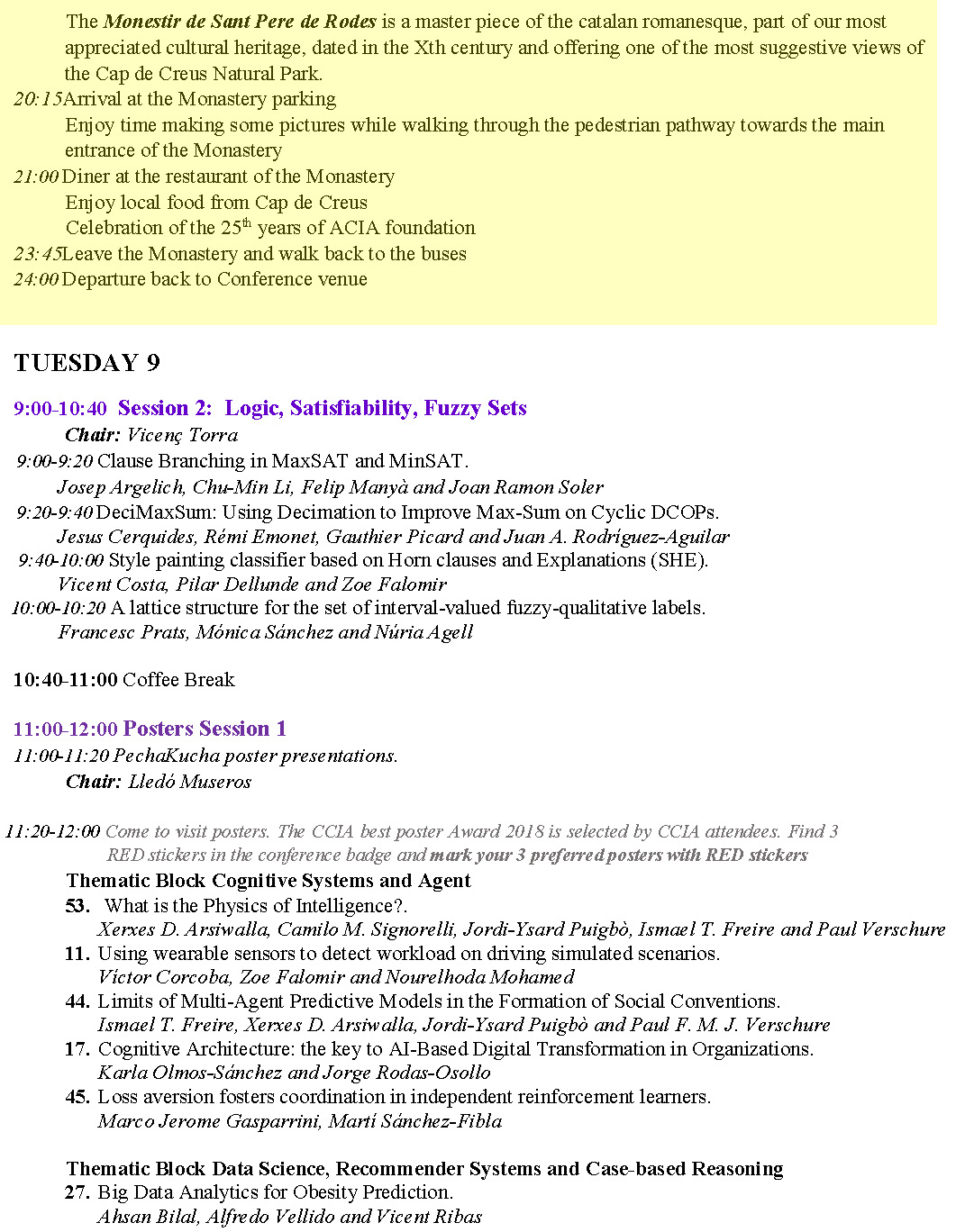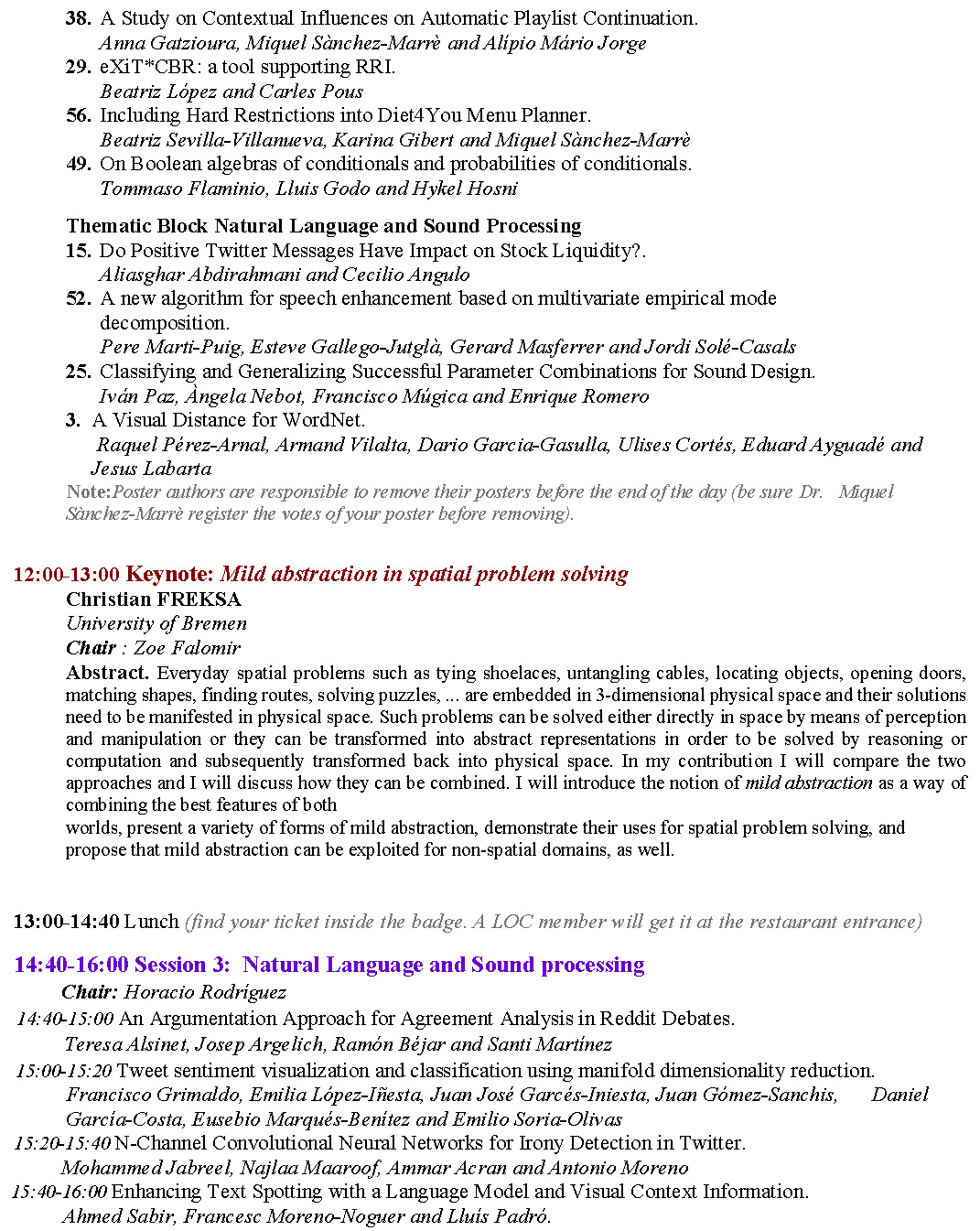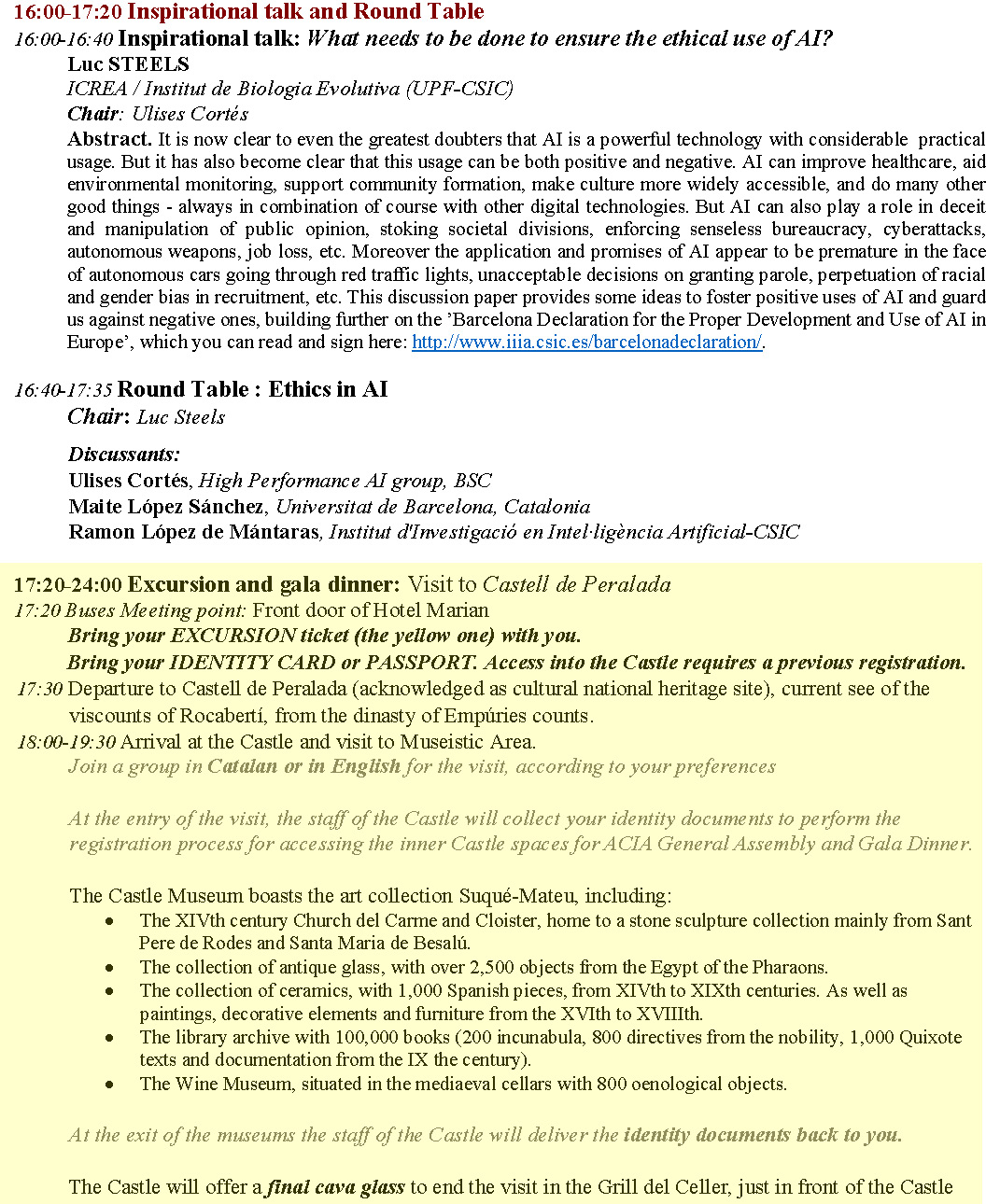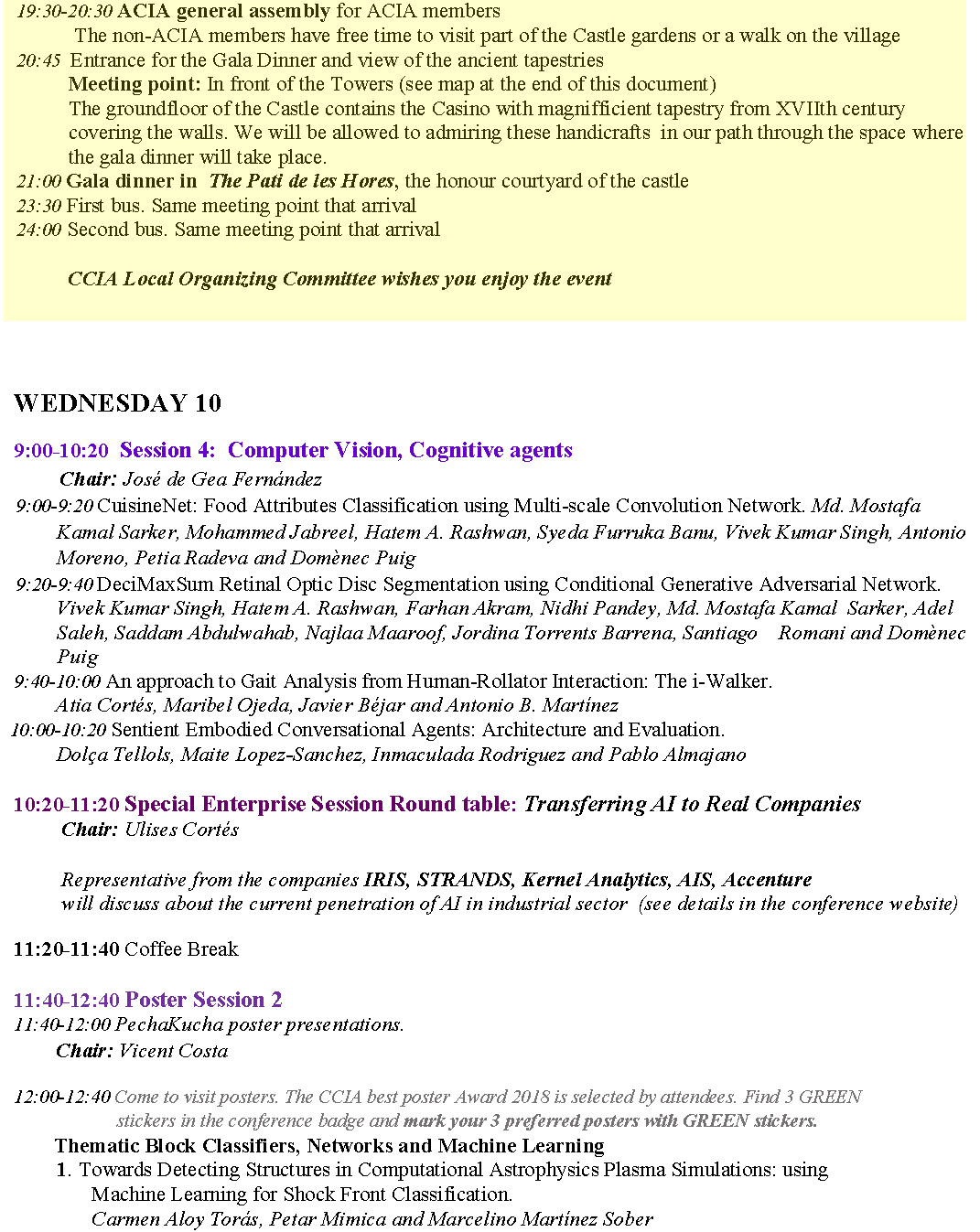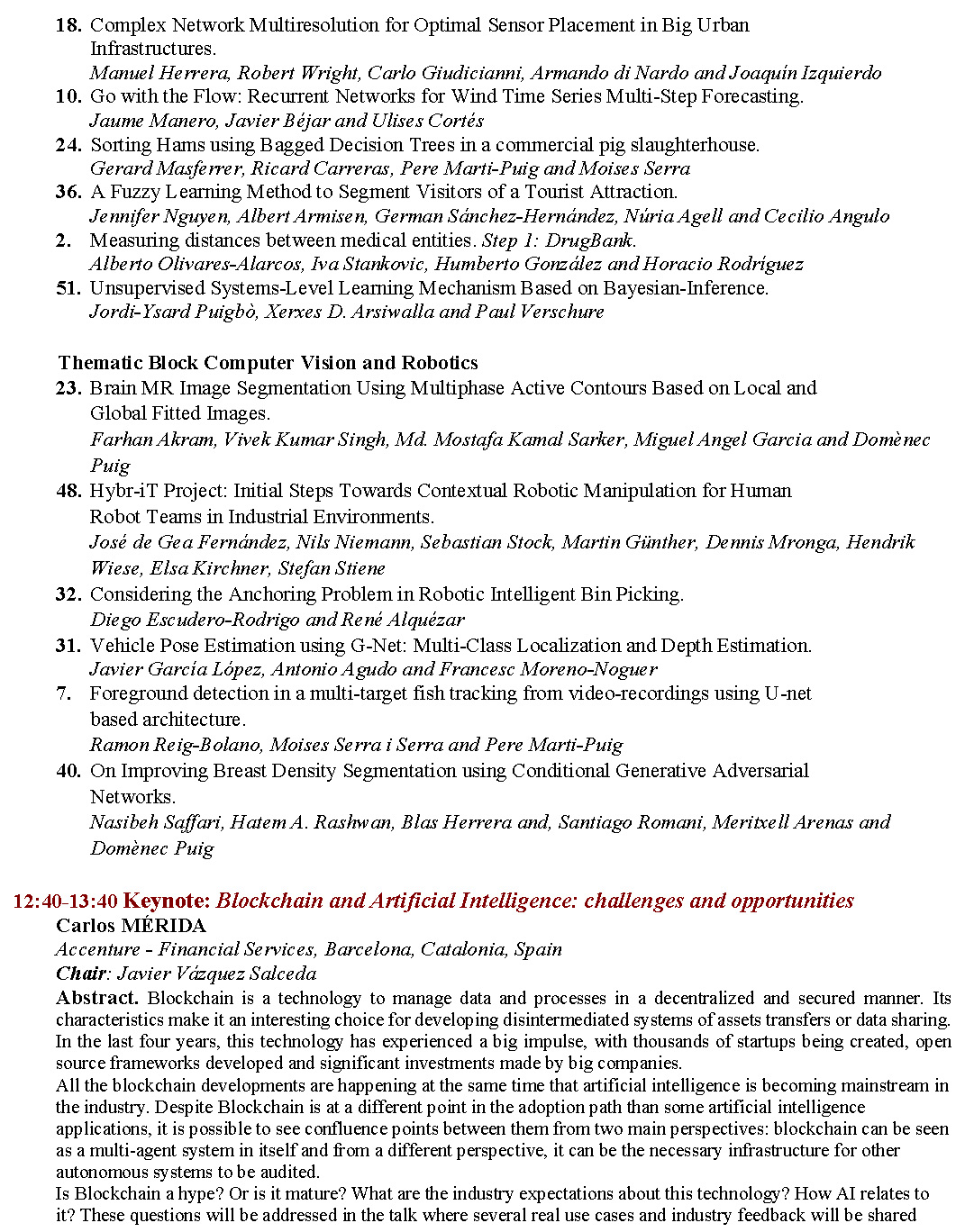Programa
Tot sobre el Programa de la Conferència
En aquesta pestanya trobareu els detalls sobre el programa de la conferència.
Si encara no us heu subscrit a les notícies de la conferència, podeu fer ara la subscripció a les notícies i rebreu informació puntual directament al vostre correu electrònic.
Conferències Convidades
Challenges of fBIG, small, Rightg Data
NTENT & Northeastern University, USA, and UPF, Catalonia
Abstract. Big data is trendy, but there are any possible interpretations of its real impact, as well as the opportunities, risks and technological challenges. We will start with two key questions: can a company use big data? If so, should it? The opportunities are clear, while the challenges are many, including scalability, bias, and privacy on the problem side, as well as transparency, explainability, and ethics on the machine learning side. So we perform an analysis that includes all the data pipeline process. At the end we will conclude that what is important is the right data, not big data. In fact, the real challenge today, is machine learning for small data.
Mild abstraction in spatial problem solving
University of Bremen
Abstract. Everyday spatial problems such as tying shoelaces, untangling cables, locating objects, opening doors, matching shapes, finding routes, solving puzzles, ... are embedded in 3-dimensional physical space and their solutions need to be manifested in physical space. Such problems can be solved either directly in space by means of perception and manipulation or they can be transformed into abstract representations in order to be solved by reasoning or computation and subsequently transformed back into physical space. In my contribution I will compare the two approaches and I will discuss how they can be combined. I will introduce the notion of mild abstraction as a way of combining the best features of both worlds, present a variety of forms of mild abstraction, demonstrate their uses for spatial problem solving, and propose that mild abstraction can be exploited for non-spatial domains, as well.
What needs to be done to ensure the ethical use of AI?
ICREA / Institut de Biologia Evolutiva (UPF-CSIC)
Abstract. It is now clear to even the greatest doubters that AI is a powerful technology with considerable practical usage. But it has also become clear that this usage can be both positive and negative. AI can improve healthcare, aid environmental monitoring, support community formation, make culture more widely accessible, and do many other good things - always in combination of course with other digital technologies. But AI can also play a role in deceit and manipulation of public opinion, stoking societal divisions, enforcing senseless bureaucracy, cyberattacks, autonomous weapons, job loss, etc. Moreover the application and promises of AI appear to be premature in the face of autonomous cars going through red traffic lights, unacceptable decisions on granting parole, perpetuation of racial and gender bias in recruitment, etc. This discussion paper provides some ideas to foster positive uses of AI and guard us against negative ones, building further on the ’Barcelona Declaration for the Proper Development and Use of AI in Europe’, which you can read and sign here: http://www.iiia.csic.es/barcelonadeclaration/.
Blockchain and Artificial Intelligence: challenges and opportunities
Accenture - Financial Services, Barcelona, Catalonia, Spain
Abstract. Blockchain is a technology to manage data and processes in a decentralized and secured manner. Its characteristics make it an interesting choice for developing disintermediated systems of assets transfers or data sharing. In the last four years, this technology has experienced a big impulse, with thousands of startups being created, open source frameworks developed and significant investments made by big companies.
All the blockchain developments are happening at the same time that artificial intelligence is becoming mainstream in the industry. Despite Blockchain is at a different point in the adoption path than some artificial intelligence applications, it is possible to see confluence points between them from two main perspectives: blockchain can be seen as a multi-agent system in itself and from a different perspective, it can be the necessary infrastructure for other autonomous systems to be audited.
Is Blockchain a hype? Or is it mature? What are the industry expectations about this technology? How AI relates to it? These questions will be addressed in the talk where several real use cases and industry feedback will be shared.
Llista de Contribucions
La llista de contribucions està agrupada en sesions temàtiques i organitzada entre presentacions orals i pòsters.
Presentacions Orals
- Clause Branching in MaxSAT and MinSAT.
Josep Argelich, Chu-Min Li, Felip Manyà and Joan Ramon Soler
- DeciMaxSum: Using Decimation to Improve Max-Sum on Cyclic DCOPs.
Jesus Cerquides, Rémi Emonet, Gauthier Picard and Juan A. Rodríguez-Aguilar
- Style painting classifier based on Horn clauses and Explanations (SHE).
Vicent Costa, Pilar Dellunde and Zoe Falomir
- A lattice structure for the set of interval-valued fuzzy-qualitative labels.
Francesc Prats, Mónica Sánchez and Núria Agell
- The Effect of Space-Time Representation Learning in Predicting People’s Next Location.
Abdulrahman Al-Molegi and Antoni Martínez Ballesté.
- Quaternion Phase CNN.
E. Ulises Moya-Sánchez, Sebastian Colores, Abraham Sánchez and Ulises Cortés.
- Towards a Universal Neural Network Encoder for Time Series.
Joan Serrà, Santiago Pascual and Alexandros Karatzoglou
- Determining Classic versus Modern Style in Fashion.
Javier Tauste, Miguel Angel González, Lledó Museros, Ismael Sanz, Dolores Llidó and Luis Gonzalez-Abril.
- A method to integrate semantic criteria into a recommender system based on ELECTRE outranking relations.
Sílvia Buira and Aida Valls
- Web pattern navigation profiling for online marketing campaigns design support under a data science approach.
Arturo Palomino and Karina Gibert
- Feature-Tree Labeling for Case Base Maintenance.
Nariman Nakhjiri, Maria Salamó and Miquel Sànchez-Marrè
- On the analysis of utility and risk for masked data in big data: a small data analysis.
Vicenç Torra
- An Argumentation Approach for Agreement Analysis in Reddit Debates.
Teresa Alsinet, Josep Argelich, Ramón Béjar and Santi Martínez
- Tweet sentiment visualization and classification using manifold dimensionality reduction.
Francisco Grimaldo, Emilia López-Iñesta, Juan José Garcés-Iniesta, Juan Gómez-Sanchis, Daniel García-Costa, Eusebio Marqués-Benítez and Emilio Soria-Olivas
- N-Channel Convolutional Neural Networks for Irony Detection in Twitter.
Mohammed Jabreel, Najlaa Maaroof, Ammar Acran and Antonio Moreno
- Enhancing Text Spotting with a Language Model and Visual Context Information.
Ahmed Sabir, Francesc Moreno-Noguer and Lluís Padró.
- CuisineNet: Food Attributes Classification using Multi-scale Convolution Network.
Md. Mostafa Kamal Sarker, Mohammed Jabreel, Hatem A. Rashwan, Syeda Furruka Banu, Vivek Kumar Singh, Antonio Moreno, Petia Radeva and Domènec Puig
- Retinal Optic Disc Segmentation using Conditional Generative Adversarial Network.
Vivek Kumar Singh, Hatem A. Rashwan, Farhan Akram, Nidhi Pandey, Md. Mostafa Kamal Sarker, Adel Saleh, Saddam Abdulwahab, Najlaa Maaroof, Jordina Torrents Barrena, Santiago Romani and Domènec Puig
- An approach to Gait Analysis from Human-Rollator Interaction: The i-Walker.
Atia Cortés, Maribel Ojeda, Javier Béjar and Antonio B. Martínez
- Sentient Embodied Conversational Agents: Architecture and Evaluation.
Dolça Tellols, Maite Lopez-Sanchez, Inmaculada Rodriguez and Pablo Almajano
Pòsters
Sessió 1
- What is the Physics of Intelligence?.
Xerxes D. Arsiwalla, Camilo M. Signorelli, Jordi-Ysard Puigbò, Ismael T. Freire and Paul Verschure
- Using wearable sensors to detect workload on driving simulated scenarios.
Víctor Corcoba, Zoe Falomir and Nourelhoda Mohamed
- Limits of Multi-Agent Predictive Models in the Formation of Social Conventions.
Ismael T. Freire, Xerxes D. Arsiwalla, Jordi-Ysard Puigbò and Paul F. M. J. Verschure
- Cognitive Architecture: the key to AI-Based Digital Transformation in Organizations.
Karla Olmos-Sánchez and Jorge Rodas-Osollo
- Loss aversion fosters coordination in independent reinforcement learners.
Marco Jerome Gasparrini, Martí Sánchez-Fibla
- Big Data Analytics for Obesity Prediction.
Ahsan Bilal, Alfredo Vellido and Vicent Ribas
- A Study on Contextual Influences on Automatic Playlist Continuation.
Anna Gatzioura, Miquel Sànchez-Marrè and Alípio Mário Jorge
- eXiT*CBR: a tool supporting RRI.
Beatriz López and Carles Pous
- Including Hard Restrictions into Diet4You Menu Planner.
Beatriz Sevilla-Villanueva, Karina Gibert and Miquel Sànchez-Marrè
- On Boolean algebras of conditionals and probabilities of conditionals.
Tommaso Flaminio, Lluis Godo and Hykel Hosni
- Do Positive Twitter Messages Have Impact on Stock Liquidity?.
Aliasghar Abdirahmani and Cecilio Angulo
- A new algorithm for speech enhancement based on multivariate empirical mode decomposition.
Pere Marti-Puig, Esteve Gallego-Jutglà, Gerard Masferrer and Jordi Solé-Casals
- Classifying and Generalizing Successful Parameter Combinations for Sound Design.
Iván Paz, Àngela Nebot, Francisco Múgica and Enrique Romero
- A Visual Distance for WordNet.
Raquel Pérez-Arnal, Armand Vilalta, Dario Garcia-Gasulla, Ulises Cortés, Eduard Ayguadé and Jesus Labarta
Sessió 2
- Towards Detecting Structures in Computational Astrophysics Plasma Simulations: using Machine Learning for Shock Front Classification.
Carmen Aloy Torás, Petar Mimica and Marcelino Martínez Sober
- Complex Network Multiresolution for Optimal Sensor Placement in Big Urban Infrastructures.
Manuel Herrera, Robert Wright, Carlo Giudicianni, Armando di Nardo and Joaquín Izquierdo
- Go with the Flow: Recurrent Networks for Wind Time Series Multi-Step Forecasting.
Jaume Manero, Javier Béjar and Ulises Cortés
- Sorting Hams using Bagged Decision Trees in a commercial pig slaughterhouse.
Gerard Masferrer, Ricard Carreras, Pere Marti-Puig and Moises Serra
- A Fuzzy Learning Method to Segment Visitors of a Tourist Attraction.
Jennifer Nguyen, Albert Armisen, German Sánchez-Hernández, Núria Agell and Cecilio Angulo
- Measuring distances between medical entities. Step 1: DrugBank.
Alberto Olivares-Alarcos, Iva Stankovic, Humberto González and Horacio Rodríguez
- Unsupervised Systems-Level Learning Mechanism Based on Bayesian-Inference.
Jordi-Ysard Puigbò, Xerxes D. Arsiwalla and Paul Verschure
- Brain MR Image Segmentation Using Multiphase Active Contours Based on Local and Global Fitted Images.
Farhan Akram, Vivek Kumar Singh, Md. Mostafa Kamal Sarker, Miguel Angel Garcia and Domènec Puig
- Hybr-iT Project: Initial Steps Towards Contextual Robotic Manipulation for Human-Robot Teams in Industrial Environments.
José de Gea Fernández, Nils Niemann, Sebastian Stock, Martin Günther, Dennis Mronga, Hendrik Wiese, Elsa Kirchner, Stefan Stiene
- Considering the Anchoring Problem in Robotic Intelligent Bin Picking.
Diego Escudero-Rodrigo and René Alquézar
- Vehicle Pose Estimation using G-Net: Multi-Class Localization and Depth Estimation.
Javier García López, Antonio Agudo and Francesc Moreno-Noguer
- Foreground detection in a multi-target fish tracking from video-recordings using U-net based architecture.
Ramon Reig-Bolano, Moises Serra i Serra and Pere Marti-Puig
- On Improving Breast Density Segmentation using Conditional Generative Adversarial Networks.
Nasibeh Saffari, Hatem A. Rashwan, Blas Herrera and, Santiago Romani, Meritxell Arenas and Domènec Puig
Baixa't la llista completa de contribucions aquí.
Intruccións per als Speakers i Pòsters
Presentacions Orals
Totes les presentacions orals disposaran de 20 min, incloent preguntes. La sala tindrà portàtil en Windows amb Office i OpenOffice disponibles. Les especificacions concretes son:
-
Microsoft Office 2016
-
Adobe Acrobat 15 DC
-
OpenOffice 4.1.5
-
VideoLAN VLC 3.0.4
Si us plau contacteu el vostre moderador abans de la vostra sessió i carregueu la presentació al PC de la sala amb prou antelació per evitar retards innecessaris durant les sessions.
Respectar la programació és esencial per al bon desenvolupament del congrés. El vostre moderador utilitzarà tarjetes de colors per indicar-vos el timing que porteu:
-
VERD: queden 5 min
-
GROG: queden 3 min
-
VERMELL: NO QUEDA TEMPS
Sessions de Pòsters
Al CCIA 2018, hi ha dues sessions de pòsters planificades per dimarts 9 de 11:00-12:00 i divendres 10 de 11:40-12:40. Dins de la Llista de Contribucions a la secció pòsters, trobareu les sessions de pòsters dividides per bloc temàtics, i cada pòster està identificat per un número.
Els moderadors de les sessions de pòsters son:
The chairman of the poster sessions are:
-
Sessió de Pòsters 1: Lledó Museros (museros@uji.es)
-
Sessió de Pòsters 2: Vicent Costa (costabuenovicente@gmail.com)
Contacteu al moderador de la vostra sessió de pòsters abans del 30 de setembre i envieu-li un ppt amb una presentació, consistent en 3 diapositives de 30 segons cadascuna i per tant, un total de 90 segons per autor, per ser enllaçades en una presentació PechaKucha-like. La primera diapositiva ha de contenir el títol del treball, els noms dels autors i les seves afiliacions. El moderador de la vostra sessió enllaçarà totes les presentacions i inclourà separadors a les diapositives indicant els blocs temàtics.
La mida de cartell no hauria de ser més gran d'un A0 (1189 x 841 mm), amb orientació vertical.
La sala de la conferència tindrà espai a les parets per penjar els pòsters. Aquesta àrea de pòsters serà degudament etiquetada amb el títol del bloc temàtic assignat al vostre treball i el número del vostre pòster (que trobeu a la web, tal com hem dit més amunt).
Podeu penjar els posters després de les sessions del dia anterior, abans de les 9:00 en punt del dia de la vostra sessió de pòsters o durant el cafè anterior a la vostra sessió. Un membre del Comitè Local proporcionarà cinta adhesiva i el suport necessari.
Les sessions de pòsters començaran amb una breu presentació oral de tots els pòsters de la sessió, a realitzar sobre la presentació que haurà preparat el moderador, a la qual cadascú podrà fer una síntesi del seu treball donant una idea clara i concisa de l'objectiu del mateix i les contribucions/resultats que s'han aconseguit.
Després de les presentacions, els autors es mouran cap als seus respectius pòsters per respondre les possibles preguntes o qüestions dels assistents.
Al final del dia, cadascú és responsable de despenjar el seu pòster vigilant de no trencar el suport. Abans de treure el pòster, assegureu-vos que el professor Miquel Sànchez Marrè ha passat a registrar els vots del vostre pòster per al Premi CCIA2018 al Millor Pòster.


